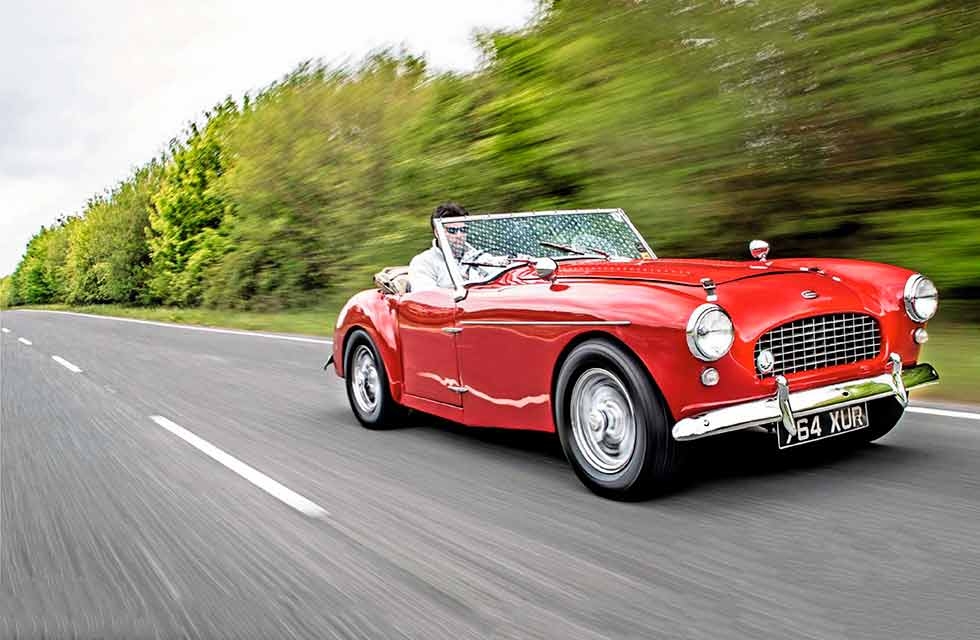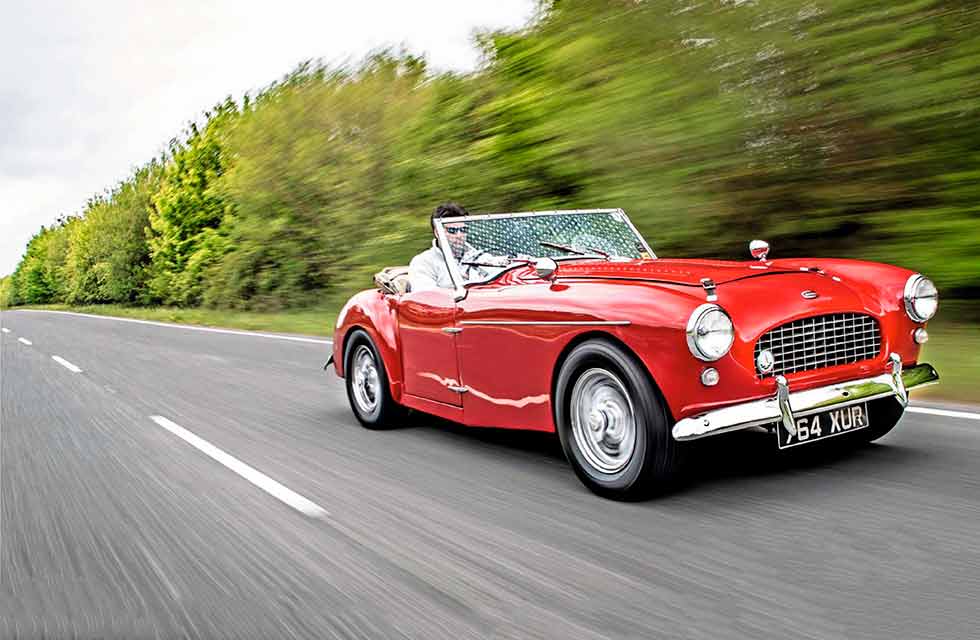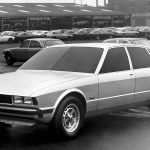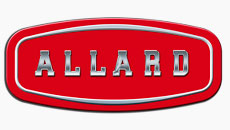
The Underdog Out on the road in the Allard Palm Beach prototype that could have saved the marque – find out why it didn’t. This factory prototype Allard Palm Beach helped create the British postwar sports car only to be annihilated both by its rivals and international politics. What did the world miss out on? Words Sam Dawson. Photography Charlie Magee.
The Underdog
You’d have to have a heart of stone not to feel sympathy for Sydney Allard. Best known for formidable, brutish proto-Cobra US V8-powered sports and GT cars, dominant in racing and rallying in the late Forties and very early Fifties, he lacked a volume seller to take him from London garagiste to major manufacturer. With the 1952 Palm Beach, he thought he’d found a unique niche to exploit and make a fortune. And found it he had – but it turned out Triumph and Austin had the same idea at exactly the same time.

This Palm Beach I’m going to drive today bore witness to this entire, tortuous process. An early prototype, not road-registered until many years after it was built, it was Sydney Allard’s rolling testbed. The car he threw various components at, trying desperately to make his big idea work as his tiny Clapham factory, clinging to traditional handbuilt processes yet attempting to keep costs competitive, was hopelessly outgunned by the Midlands giants at Longbridge and Canley. But as the savage snarl and urgent thrust from beneath that disproportionately long bonnet attests, it seems Allard was onto something neither Triumph nor Austin could counter – well, not quite yet.
I first encounter it outside the kind of rural barn that often doubled as a mechanic’s workshop and petrol station in the Forties. The passage of time has a habit of rendering once- controversial design appealing with sheer period charm, but the looks of the Palm Beach were one of the factors that hobbled it from the start. Sydney Allard conceived of the car to be a major US draw at a time when the biggest-selling British sports car out there was the cycle-winged, vintage-looking MG TD. Allard looked at the new wave of expensive exotica coming out of Europe and reasoned that a new machine, MG-simple and based on mass- produced Ford Consul and Zephyr components, yet slickly full- bodied in the style of something from an Italian carrozzeria, would mark the way forward for the affordable British sports car. The name spoke of the glamour Allard hoped to tap into, as well as the prospective target market.
But Allard’s in-house styling effort didn’t impress his would-be American dealers on his tour of the country with a left-hand drive prototype. Identifiable as a prototype by single rather than twin fuel-filler caps, and a crude flat-panel dashboard compared with the more professional-looking sculpted items of the production cars, it’s likely this factory hack was part of the same early batch. The American reaction to the styling was so negative that, during his trip, Allard arranged a meeting with Joe Frazer of Graham- Paige – no longer a manufacturer of extravagant art-deco luxury cars, but a major player in the burgeoning plastics industry – to discuss the idea of supplying Palm Beaches to the US minus their factory aluminium bodies, to be fitted with glassfibre ’shells styled to American tastes. But the plan came to nothing.
Stand close to this Palm Beach’s front three-quarters, looking down across the bonnet, and there’s actually a hint of XL-sized Cisitalia in its oval grille, curvaceous wings and long, louvred bonnet. But take so much as a single step in either direction and the illusion falls apart. From the front it’s too tall and bluff, the air intake a gaping grimace. From the side, the front half begins well before running into slabby doors with amateurish external hinges, panel gaps that’d shame a Ford Pop Special, and a tail that attempts elegance with a swell beginning in front of the rear wheels, but carelessly throws it away with a dumpy conclusion rather than an XK120-style taper before meeting the rear bumper.
The sense of amateurism continues as I swing open the flyaway- light aluminium door and slide aboard. There’s plenty of legroom for a sports car of this era – far more than in a Jaguar XK120 – but the floor is comically uneven in order to accommodate the steel chassis tubes beneath. I keep having to remind myself that this is a rough-hewn prototype, but even so the foot pedals seem devised almost to prevent heel-and-toe gearchanges. The accelerator is buried deep in the footwell, a calf-straining stretch away, while the brake pedal is several inches closer to the driver and mounted on a higher section of floor, so there’s nowhere where you can usefully – or comfortably – rest your right foot and retain a sense of control.
But hit the starter and the Allard reveals its advantage in a deep, silken boom from beyond the bulkhead. Sydney Allard might have looked on in horror at the Earls Court Motor Show in 1952 as Triumph unveiled the £380-cheaper TR2 prototype and Healey its much slicker, and just £78 dearer 100. However, both were four-cylinder cars. While a 1508cc Consul four-cylinder featured in the entry-level £1245 Palm Beach, most would be £1347 Zephyr-powered 2262cc straight-six versions. Given that the initial eye-catching £1263 for an XK120 rapidly rose to £1598, this looked set to put the Palm Beach in a market of its own at a time when most vehicles considered supercars also had six cylinders.
This car started life with one of those early engines – whether it was a four or a six is now unknown – but the engine it ended up with helps to tell the next chapter of the Palm Beach story. The torquey six surging me out of this quiet Essex village actually displaces 2553cc, with an exotic-looking Aquaplane intake manifold wearing three SU AUC810 carburettors. The engine number is 21P2498X, the final letter betraying its status as an experimental pre-production unit straight from Ford, built ahead of MkII Zephyr production. This engine began life in 916 AVX, the Jack Welch-prepared Zephyr MkI that Sidney Allard used to contest the 1955 Monte Carlo Rally, as did its experimental four- speed gearbox. Ordinary Zephyrs back then made do with three.
The intake manifold has its origins in another Palm Beach experiment, a factory demonstrator registered NYO 66, which Allard sent away to Raymond Mays of ERA for triple-carburettor modification – originally Zeniths rather than SUs – to its Zephyr straight-six. In 1956, strapped for cash and with no suitable Allards of his own left to rally, Sydney united May’s Aquaplane were four-cylinder cars. While a 1508cc Consul four-cylinder featured in the entry-level £1245 Palm Beach, most would be £1347 Zephyr-powered 2262cc straight-six versions. Given that the initial eye-catching £1263 for an XK120 rapidly rose to £1598, this looked set to put the Palm Beach in a market of its own at a time when most vehicles considered supercars also had six cylinders.
This car started life with one of those early engines – whether it was a four or a six is now unknown – but the engine it ended up with helps to tell the next chapter of the Palm Beach story. The torquey six surging me out of this quiet Essex village actually displaces 2553cc, with an exotic-looking Aquaplane intake manifold wearing three SU AUC810 carburettors. The engine number is 21P2498X, the final letter betraying its status as an experimental pre-production unit straight from Ford, built ahead of MkII Zephyr production. This engine began life in 916 AVX, the Jack Welch-prepared Zephyr MkI that Sidney Allard used to contest the 1955 Monte Carlo Rally, as did its experimental four- speed gearbox. Ordinary Zephyrs back then made do with three.
The intake manifold has its origins in another Palm Beach experiment, a factory demonstrator registered NYO 66, which Allard sent away to Raymond Mays of ERA for triple-carburettor modification – originally Zeniths rather than SUs – to its Zephyr straight-six. In 1956, strapped for cash and with no suitable Allards of his own left to rally, Sydney united May’s Aquaplane race-tuned AC Aces streaking by the pitlane at Goodwood. It makes me realise how close to greatness the Palm Beach might have come if Allard had executed it as finely and beautifully as the semi-exotic from Thames Ditton. At 70mph the racket is neatly subdued by fourth gear, and while the car hinted at its smooth cruising attributes as I negotiated country lanes earlier, it genuinely impresses at speed. Provisions made for a pair of fly-screens suggest the full-sized windscreen was only fitted later once Allard sold the car on, but that big windscreen is doing an excellent job of subduing wind noise on the motorway. I’m not feeling calm though, because of those old drum brakes; as an HGV abruptly swerves into the lane in front of me, I find myself eyeing the hard shoulder, mentally preparing to take any necessary evasive action.
But brakes can be adjusted. Interior ergonomic issues could be comprehensively addressed following a battery of test-drives too. Crucially, this time-served testbed accelerates, steers and accommodates as well as (if not better than) most of its Fifties rivals. For a car whose specification only pointed to what Allard was about to do next, it’s a remarkably well-polished effort. It feels like it could form the basis of something superb.
Allard unveiled his Palm Beach MkII at the Earls Court Motor Show in October 1956. Abandoning the notion of Austin Healey- style mass-production, he repositioned the Palm Beach as an exclusive bespoke sophisticate, using the tagline ‘Built For You’. The four-cylinder option was dropped, the triple-Zenith cylinder head was standardised on the 2553cc Zephyr six, and an attempt was made at a sub-supercar with the option of a 3442cc Jaguar engine from the XK150SE. The pedals were evened-up in the footwell too. But best of all, the MkI’s crude, dumpy styling was replaced by a wasp-waisted new body, beautiful from every angle.
Sydney Allard must have beamed as showgoers flocked to the stand, eagerly placing orders. But yet another gut-wrenching turn of events resulted in Allard making a grand total of eight.
Just 12 days after the new Palm Beach made its successful debut at Earls Court, the Israeli army invaded the Egyptian Sinai in an attempt to seize control of the Suez Canal after the Egyptian President Nasser nationalised it. French and British troops supported the assault, in what later emerged to have been a pre-planned conspiracy between the three nations.
The Suez Crisis led to the resignation of Prime Minister Anthony Eden, and disruption to the Canal blocked oil shipments from the Persian Gulf. Petrol supplies slumped, prices soared, fuel rationing was mooted and in the space of four days the Bank of England lost $45m and approached the International Monetary Fund for help.
In an atmosphere of recession, uncertainty regarding petrol prices and fear of another World War, Allard’s potential customers reclaimed their deposits. His dream of semi-volume production was over. He tried one last time, by taking the Palm Beach even further upmarket as a £2140 fastback-hardtop XK-engined GT for the 1957 Earls Court show. Problem was, an XK150SE was £2065, far better finished and backed by a comprehensive dealer network.
This failure forced Allard to rethink. At this point this car – one of the earliest Palm Beaches made, yet the last to be registered – was officially put on the road and sold off. Allard saw an exciting new trend – drag racing – and hurled his Clapham works into it.
I can’t help but think that the Palm Beach could have been a success. It had the same raw materials as the AC Ace, it’s just that they didn’t combine in quite the right order at the right time to succeed like that car did. I even find myself speculating that Allard’s history of American V8-powered specials might have resulted in a distinctively Cobra-like evolution further down the line too.
This prototype ended up as the first and last iteration of Sydney’s version of a great idea. But that was the same idea that gave us the Ace, straight-six Austin-Healeys, the Triumph TR5 and everything they inspired – Datsun 240Z included. As legacies go, that’s a big one.
Thanks to totalheadturners.com where the car is for sale
This prototype was one of the earliest Palm Beaches made. Styling improved immeasurably with the later MkII version. Modified Ford straight-six has deep reserves of low-down torque and gives a full-blooded howl under hard acceleration. This prototype’s ergonomic issues were ultimately addressed for production. Aquaplane cylinder-headed straight-six has Monte Carlo R ally provenance.
1952/7 Allard Palm Beach prototype
Engine 2553cc inline six-cylinder, ohv, three SU AUC810 carburettors (originally Zenith)
Max power 90bhp @ 4400rpm
Max torque 139lb ft @ 2000rpm
Transmission Four- speed manual, rear-wheel drive
Steering Worm and roller
Suspension
Front: independent, MacPherson struts, semi- trailing arms, coil springs, telescopic dampers. Rear: Live axle, Panhard rod, twin radius arms, coil springs, telescopic dampers
Brakes Servo-assisted drums front and rear
Weight 1016kg (2239lb)
Performance in excess of:
Top speed: 99mph;
0-60mph: 11.6sec (standard Palm Beach MkII with three-speed transmission)
Fuel consumption 20mpg
Cost new n/a
Asking price £76,000
LIVING WITH 764 XUR
Says this Palm Beach’s former owner Julian Sutton, ‘I was brought up in the war years, with the dreary cars of the Forties, so Sydney Allard was an early hero of mine, with his exploits at Le Mans and Monte Carlo. When a well-off neighbour took me to school in his brand new silver Allard M1 – overpowered, oversteering, flies in the teeth – I was smitten forever.
Td owned a host of hairy motor cars since, including Grand Prix cars and a Jaguar-engined MkII Palm Beach, so when this one came up for sale in Portugal, I just had to have it.
1 bought it sight-unseen, and my first journey in it was also the longest – 1000km through Portugal and Spain, onto the
overnight ferry from Bilbao to Southampton, then on home to Cambridge. The two days were not without incident! The offside rear brake seized on, the ignition key jammed and failed to turn off, the fuel gauge and speedometer failed to read correctly, and there was significant bump-steer and steering play. Rainwater bypassed the hood and windscreen.
‘Rather than tackle each job, my team and I stripped the car to its bare chassis and repaired or replaced everything required. The delight is that all components are Ford Zephyr. But the bodywork cost £12k to restore and paint, interior retrim was £800, engine £1500 including new carburettors, and machining hubs, new wheels and tyres came to £2000.
Julian Sutton has lived with the Allard for three years







